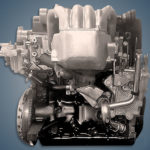The 6.0-liter Audi CCGA or V12 TDi diesel engine was assembled only from 2008 to 2012 and was installed only on charged versions of the popular first-generation Q7 crossover. This power unit is the most powerful diesel that was installed on civilian cars.
The EA898 series also includes: AKF, ASE, BTR, CKDA, CCGA, CZAC, DHVA.
In 2006, a 5.5-liter V12 diesel engine debuted on the Audi R10 racing car, which was then adapted for installation on the Q7 crossover, where its volume increased to 5.9 liters. By design, this is a V-engine with a cast-iron block and a 60° camber angle, aluminum DOHC cylinder heads with hydraulic lifters, a multi-chain timing drive, two Garrett GTB2260VK water-cooled turbochargers and a pair of intercoolers, as well as a Bosch Common Rail fuel system with piezo injectors for 2000 bar. The result is the most powerful diesel engine for passenger cars, developing 500 hp and 1000 Nm.
Specifications
| Production years | 2008-2012 |
| Displacement, cc | 5934 |
| Fuel system | Common Rail |
| Power output, hp | 500 |
| Torque output, Nm | 1000 |
| Cylinder block | cast iron V12 |
| Block head | aluminum 48v |
| Cylinder bore, mm | 83 |
| Piston stroke, mm | 91.4 |
| Compression ratio | 16.0 |
| Hydraulic lifters | yes |
| Timing drive | chains |
| Turbocharging | two Garrett GTB2260VK |
| Recommended engine oil | 5W-30, 5W-40 |
| Engine oil capacity, liter | 13.0 |
| Fuel type | diesel |
| Euro standards | EURO 5 |
| Fuel consumption, L/100 km (for Audi Q7 2009) — city — highway — combined |
14.8 9.3 11.3 |
| Engine lifespan, km | ~500 000 |
| Weight, kg | 360 |
The engine was installed on:
- Audi Q7 1 (4L) in 2008 – 2012.
Disadvantages of the Audi CCGA engine
- Q7 with this diesel has ten radiators that need to be washed regularly or the engine will constantly overheat and soon oil will come out of all its seals.
- The CR Bosch system is very reliable, but the piezo injectors are demanding on fuel quality, and if you pour anything into the tank, then they may need to be replaced by 100 thousand kilometers.
- Despite water cooling, both turbochargers here are quite thermally loaded and overly active owners usually do not go more than 100 – 150 thousand kilometers.
- Another weak point of the motor is the swirl flaps of the intake manifold: the electric motors of their drive often fail or the hinges simply break.
- Also, failures on control units regularly occur, the EGR system quickly clogs up.






